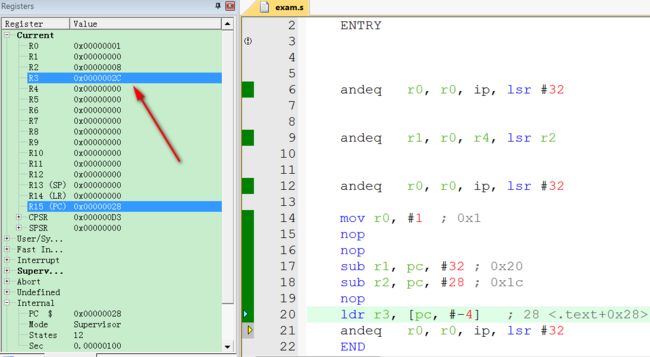参考文档:
the Gnu Linker ld
3.5.4 Source Code Reference
Accessing a linker script defned variable from source code is not intuitive. In particular a
linker script symbol is not equivalent to a variable declaration in a high level language, it
is instead a symbol that does not have a value.
从源文件中访问链接脚本中定义的变量不能直接访问,链接脚本中的变量是一个符号而不是一个具体的值
Before going further, it is important to note that compilers often transform names in the
source code into different names when they are stored in the symbol table. For example,
Fortran compilers commonly prepend or append an underscore, and C++ performs extensive
‘name mangling’. Therefore there might be a discrepancy between the name of a variable
as it is used in source code and the name of the same variable as it is defned in a linker
script
For example in C a linker script variable might be referred to as:
extern int foo;
But in the linker script it might be defned as:
_foo = 1000;
however it is assumed that no name transformation has taken place.
编译器通常会把源代码中的name(变量名或者函数名)进行转换然后在存放在symbol table,例如fortran通常会在name的前或后加下划线,因此相同的变量在源代码中和链接脚本中名字可能不一样
When a symbol is declared in a high level language such as C, two things happen. The frst is that the compiler reserves enough space in the program’s memory to hold the value of
the symbol. The second is that the compiler creates an entry in the program’s symbol table
which holds the symbol’s address. ie the symbol table contains the address of the block of memory holding the symbol’s value. So for example the following C declaration, at fle scope
int foo = 1000;
creates a entry called ‘foo’ in the symbol table. This entry holds the address of an ‘int’
sized block of memory where the number 1000 is initially stored.
在c语言里面声明一个symbol,首先编译器会保留足够的空间去存储这份symbol的值,然后会在符号表中添加一个条目来保存symbol的值,例子说的很明确,首先symbol table中会添加一个entry,名字叫做foo,这个entry保存着foo变量的地址,地址里面存的内容是1000
When a program references a symbol the compiler generates code that frst accesses the
symbol table to fnd the address of the symbol’s memory block and then code to read the
value from that memory block. So:
//程序引用一个symbol时首先在symbol table里面查找symbol的地址,然后在把这个地址里面的数据读取出来
foo = 1;
looks up the symbol ‘foo’ in the symbol table, gets the address associated with this symbol
and then writes the value 1 into that address.
//这个例子说明对变量foo的访问首先去 symbol table获取foo地址,然后往改地址写入1
Whereas:
int * a = & foo;
looks up the symbol ‘foo’ in the symbol table, gets it address and then copies this address
into the block of memory associated with the variable ‘a’
//foo的地址 --->a变量
Linker scripts symbol declarations, by contrast, create an entry in the symbol table but donot assign any memory to them. Thus they are an address without a value. So for example the linker script defnition:
//链接脚本里声明变量的话只会在symbol table里面添加entry,不会为其分配内存.
foo = 1000;
creates an entry in the symbol table called ‘foo’ which holds the address of memory location
1000, but nothing special is stored at address 1000. This means that you cannot access the
value of a linker script defned symbol - it has no value - all you can do is access the address
of a linker script defned symbol.
上面的例子只是在symbol table创建了一个foo,地址是1000,1000为地址的内存里面什么内容都没有,所以你不能访问foo(1000里面的内容),你只能获取foo的地址(1000)
Hence when you are using a linker script defned symbol in source code you should always
take the address of the symbol, and never attempt to use its value. For example suppose
you want to copy the contents of a section of memory called .ROM into a section called
.FLASH and the linker script contains these declarations:
start_of_ROM = .ROM;
end_of_ROM = .ROM + sizeof (.ROM) - 1;
start_of_FLASH = .FLASH;
Then the C source code to perform the copy would be:
extern char start_of_ROM, end_of_ROM, start_of_FLASH;
memcpy (& start_of_FLASH, & start_of_ROM, & end_of_ROM - & start_of_ROM);
Note the use of the ‘&’ operators. These are correct.
c代码中使用变量见上方,需要用extern声明.然后在取地址.
asm文件里面怎么使用呢?好像是可以直接就使用.word把__bss_start的值存在标号_bss_start处相当于*_bss_start = __bss_start的值
.globl _bss_start
_bss_start:
.word __bss_start
另外一个自己做实验的例子
Makefile
exam.bin:exam1.o
arm-linux-ld -Texam.lds -o exam1_elf $<
arm-linux-objdump -D -m arm exam1_elf > exam1_dis
%.o:%.c
arm-linux-gcc -c $<
%.o:%.S
arm-linux-gcc -c $<
clean:
rm *.o *.bin *_dis *_elf
exam.lds链接脚本
SECTIONS {
.text : {*.text}
__bss_start = .;
__bss_end = .;
__dd = .;
}
exam1.S文件,我直接使用lds脚本里的__dd,取其值存入r3,编译竟然能通过.也没有报错说没有找到__dd.
.global _start
.global _bss_start
_bss_start:
.word __bss_start
.global abcd
abcd:
.word 0x1234
.global _dd
_dd:
.word __dd
_start:
mov r0, #1
nop
nop
adr r1, _bss_start
adr r2, _dd
nop
ldr r3, =__dd
查看.text段有多大,大小是0x2c,反汇编看一下最终r3寄存器是不是0x2c
book@book-desktop:~/exam/inline_asm$ objdump -h exam1_elf
exam1_elf: file format elf32-little
Sections:
Idx Name Size VMA LMA File off Algn
0 .text 0000002c 00000000 00000000 00008000 2**2
CONTENTS, ALLOC, LOAD, READONLY, CODE
1 .glue_7 00000000 0000002c 0000002c 0000802c 2**2
CONTENTS, ALLOC, LOAD, READONLY, CODE
2 .glue_7t 00000000 0000002c 0000002c 0000802c 2**2
CONTENTS, ALLOC, LOAD, READONLY, CODE
3 .data 00000000 0000002c 0000002c 0000802c 2**0
CONTENTS, ALLOC, LOAD, DATA
4 .bss 00000000 0000002c 0000002c 0000802c 2**0
ALLOC
exam1_dis反汇编文件
24: e51f3004 ldr r3, [pc, #-4] ; 28
r3确实是0x2c
exam1_elf: file format elf32-littlearm
Disassembly of section .text:
00000000 <_bss_start>:
0: 0000002c andeq r0, r0, ip, lsr #32
00000004 :
4: 00001234 andeq r1, r0, r4, lsr r2
00000008 <_dd>:
8: 0000002c andeq r0, r0, ip, lsr #32
0000000c <_start>:
c: e3a00001 mov r0, #1 ; 0x1
10: e1a00000 nop (mov r0,r0)
14: e1a00000 nop (mov r0,r0)
18: e24f1020 sub r1, pc, #32 ; 0x20
1c: e24f201c sub r2, pc, #28 ; 0x1c
20: e1a00000 nop (mov r0,r0)
24: e51f3004 ldr r3, [pc, #-4] ; 28 <.text+0x28>
28: 0000002c andeq r0, r0, ip, lsr #32
把反汇编的代码拿到keil里去仿真,结果与上面分析的一致
